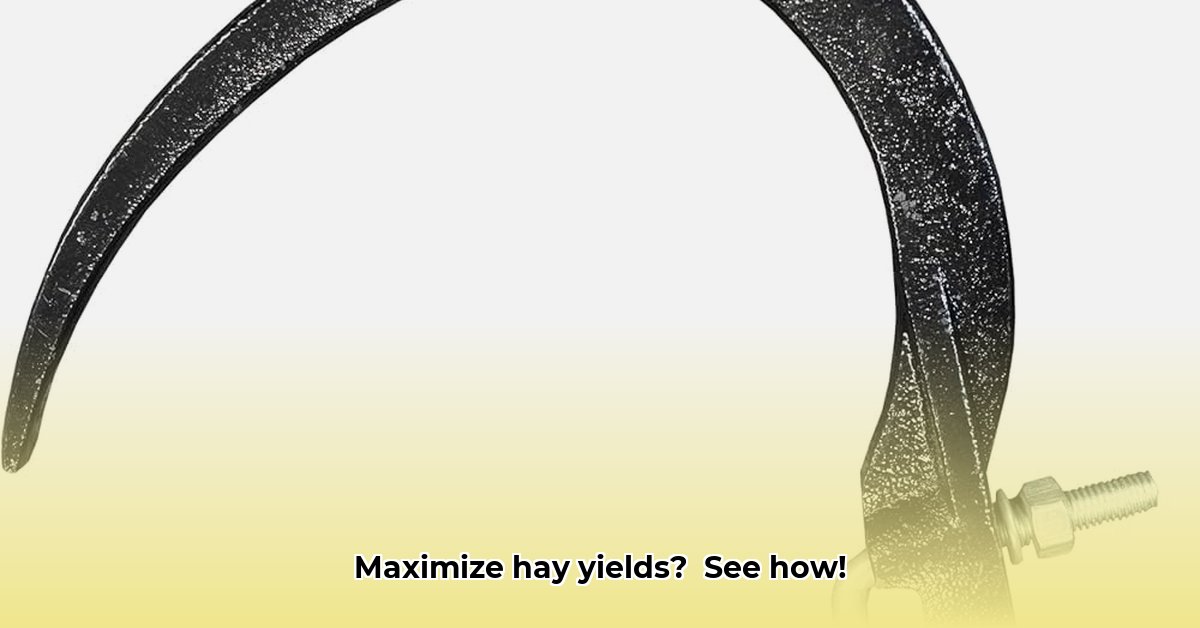
Hay Hooks and Sustainable Hay Production: A Practical Guide
This guide provides a step-by-step approach to sustainable hay production, maximizing yields while minimizing environmental impact and boosting your bottom line. We'll cover equipment selection, fertilization, soil health, water management, harvesting techniques, and the financial considerations involved in transitioning to more sustainable practices. Remember, even small changes can make a big difference. For more information on hay, check out this helpful resource: Hay Production Guide.
Gear Up for Success: Choosing the Right Equipment
Efficient hay production starts with the right tools. Tractor Supply’s hay hooks (and similar tools from other retailers) are a great starting point, offering ergonomic benefits that reduce back strain and improve efficiency. Consider weight capacity and handle design for optimal comfort and productivity.
Beyond hay hooks, your baler is a critical investment. The size and type of baler depend on your operation's scale and the type of hay you harvest. Look for fuel-efficient models to reduce operating costs and your environmental footprint. Also, consider the baler's impact on soil compaction; lighter equipment minimizes soil damage, promoting healthier growth and water absorption. Investing in efficient, less-compacting equipment is a significant step toward sustainable hay production. Don’t underestimate the long-term benefits of choosing wisely!
Fertilizer: Precision Application for Profit and the Planet
Over-fertilizing wastes money and harms the environment. Instead, prioritize precision agriculture techniques. A simple soil test provides crucial insights into your soil's composition, guiding you towards targeted fertilizer application. This approach minimizes waste, reduces nutrient runoff into waterways, and improves the overall health of your soil. Precision agriculture is not just an environmental win; it also substantially contributes to cost reduction and increased yields. Did you know that targeted fertilization can increase yields by up to 15%?
Soil Health: The Cornerstone of Sustainable Hay Production
Healthy soil is the foundation of a productive hay farm. Practices like crop rotation (alternating crops to prevent nutrient depletion) and cover cropping (planting crops between hay harvests to improve soil health) are crucial for long-term sustainability. Cover crops add organic matter, prevent erosion, and improve water retention, creating fertile ground for your hay crops. Investing in soil health translates directly to increased yields and reduced reliance on chemical fertilizers — a win-win for your bottom line and the environment. What are your current soil health management practices?
Water Wise: Efficient Irrigation and Drought Resilience
Efficient irrigation is crucial, especially in drier regions. Drip irrigation delivers water directly to plant roots, minimizing evaporation and maximizing water use efficiency. Consider drought-resistant grass varieties to further reduce your reliance on irrigation. Investing in water-efficient practices not only conserves a precious resource but also reduces your operating costs. How much could you save on water bills by implementing these techniques?
Harvesting Smart: Optimizing Yields and Minimizing Waste
Harvest timing significantly impacts hay nutritional value and yield. Harvest at peak maturity for optimal results. Efficient baling techniques (round or square bales) minimize losses. Don’t forget the role of your hay hooks—they contribute to faster, safer handling and storage, reducing crop losses and improving overall hay quality. Efficient harvesting ensures that you maximize yields while minimizing waste and maximizing profit. Are you optimizing your harvest timing for maximum yield?
Financial Considerations: The Long-Term ROI of Sustainability
While transitioning to sustainable practices may require an initial investment in new equipment or technologies, the long-term return on investment is substantial. Reduced fertilizer and water costs, combined with increased yields and improved hay quality, lead to significant cost savings and increased profitability. Keeping detailed records of your expenses and yields will allow you to quantify the benefits of sustainable practices and demonstrate their positive impact on your bottom line. Have you calculated the long-term return on sustainable investments in your hay production?
"The initial investment in sustainable practices may seem daunting, but the long-term financial benefits, coupled with the environmental stewardship, make it a worthwhile undertaking," says Dr. Emily Carter, Agricultural Economist, University of California, Davis.
A Balanced View: Weighing Practices and Trade-offs
Sustainable hay production requires thoughtful consideration of various practices and understanding their potential trade-offs. This table summarizes some key practices, highlighting their advantages and disadvantages:
| Practice | Pros | Cons |
|---|---|---|
| Precision fertilizer application | Reduced costs, environmental protection, higher yields | Higher upfront investment in technology |
| Crop rotation | Improved soil health, reduced pests/diseases, increased yields | Requires careful planning and management |
| Cover cropping | Soil improvement, erosion control, reduced fertilizer needs | May require additional labor and seed costs |
| Drought-resistant varieties | Reduced water use, increased yields in dry conditions | May have slightly lower yields in ideal conditions |
| Efficient harvesting | Reduced losses, minimized energy use, better hay quality | Requires careful planning and execution, potentially new equipment |
Remember, sustainable hay production is an ongoing process of improvement. Start with small, manageable changes, and gradually integrate more sustainable practices as you learn and adapt. The benefits, both for your farm's profitability and the environment, are substantial.